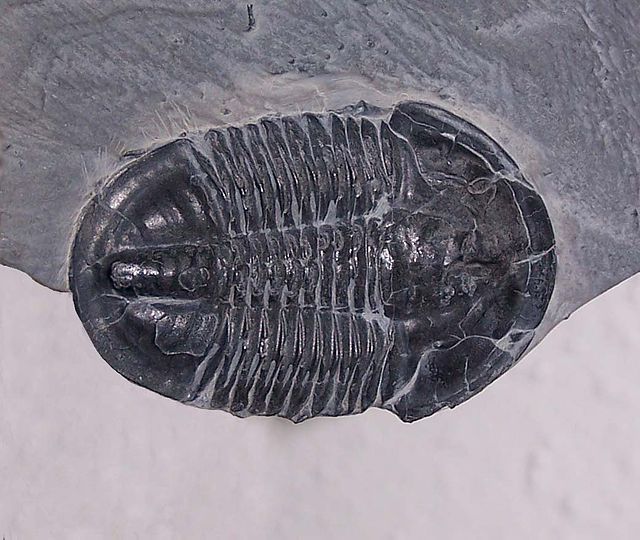Top Qs
Timeline
Chat
Perspective
Wheeler Shale
Geologic formation in Utah notable for trilobite fossils From Wikipedia, the free encyclopedia
Remove ads
The Wheeler Shale (named by Charles Walcott) is a Cambrian (c. 507 Ma) fossil locality world-famous[1] for prolific agnostid and Elrathia kingii trilobite remains (even though many areas are barren of fossils)[2] and represents a Konzentrat-Lagerstätte. Varied soft bodied organisms are locally preserved, a fauna (including Naraoia, Wiwaxia and Hallucigenia) and preservation style (carbonaceous film) normally associated with the more famous Burgess Shale.[3] As such, the Wheeler Shale also represents a Konservat-Lagerstätten.[4]
Together with the Marjum Formation and lower Weeks Formation, the Wheeler Shale forms 490 to 610 m (1,610 to 2,000 ft) of limestone and shale exposed in one of the thickest, most fossiliferous and best exposed sequences of Middle Cambrian rocks in North America.[5]
At the type locality of Wheeler Amphitheater, House Range, Millard County, western Utah, the Wheeler Shale consists of a heterogeneous succession of highly calcareous shale, shaley limestone, mudstone and thin, flaggy limestone.[6] The Wheeler Formation (although the Marjum & Weeks Formations are missing) extends into the Drum Mountains, northwest of the House Range where similar fossils and preservation are found.[6]
Remove ads
Taphonomy and sedimentology


Detailed work recognises a number of ~10 m thick lagerstätten sequences in the formation, each of which formed at a sea-level highstand[7] in deep water.[8] The lagerstätte were deposited by turbidities and mudslides onto an oxygenated sea floor.[7] The productive layers comprise mud and clay particles, with a tiny fraction of wind-blown quartz.[9]
Remove ads
Stratigraphy
The Wheeler Shale spans the Ptychagnostus atavus[10] and uppermost-Middle Cambrian Bolaspidella trilobite zones (See House Range for full stratigraphy).
Fauna

Incomplete list of the fauna of the Wheeler Shale:[6][11][12][13][14][15][16] (Note: the preservation of hard bodied trilobite remains and soft bodied animals seems to be mutually exclusive within particular horizons.)[4][17]
Protista
- Marpolia spissa - cyanobacteria or green algae
- Morania fragmenta - cyanobacteria
Arthropoda
- Branchiocaris pretiosa - hymenocarine
- Branchiocaris sp.
- Cambropodus gracilis - possible myriapod
- Canadaspis perfecta - hymenocarine
- Dicerocaris opisthoeces
- Emeraldella brocki - vicissicaudatan
- Isoxys
- Perspicaris dilatus hymenocarine
- Pseudoarctolepis sharpi - possible hymenocarine
- Tuzoia? peterseni hymenocarine
- Waptia fieldensis hymenocarine
- Alalcomenaeus cambricus - megacheiran; or alalcomenaeid
- Dicranocaris guntherorum - possible megacheiran?
- Mollisonia symmetrica - mollisoniid chelicerate
- Leanchoilia superlata - megacheiran
- Sidneyia inexpectans - vicissicaudatan
Dinocaridida
- Amplectobelua cf. A. stephenensis – radiodont[18]
- Anomalocarididae gen. et sp. nov. - radiodont[18]
- Buccaspinea cooperi? - radiodont[18]
- Caryosyntrips durus - radiodont[18]
- Caryosyntrips serratus - radiodont[18]
- Peytoia nathorsti - radiodont[18]
- Pahvantia hastata - radiodont[18]
- Stanleycaris sp. - radiodont[18]
- Utahnax vannieri - kerygmachelid lobopodian, possibly from Marjum Formation[19]
- Utaurora comosa - opabiniid[20]
Trilobita
- Naraoia compacta - naraoiid nectaspid
- Hypagnostus parvifrons - agnostid
- Peronopsis amplaxis - peronopsid agnostid
- Peronopsis bidens
- Peronopsis fallax
- Peronopsis gaspensis
- Peronopsis intermedius
- Peronopsis interstrictus
- Peronopsis montis
- Peronopsis segmentis
- Ptychagnostus atavus (= Acidusus atavus) - ptychagnostid agnostid
- Ptychagnostus germanus
- Ptychagnostus gibbus
- Ptychagnostus intermedius
- Ptychagnostus michaeli
- Ptychagnostus occultatus
- Ptychagnostus seminula
- Glyphaspis concavus - asaphid
- Bathyuriscus fimbriatus - dolichometopid corynexochid
- Bathyuriscus sp.
- Kootenia sp. - dorypygid corynexochid, perhaps a synonym of Olenoides
- Olenoides expansus - dorypygid corynexochid
- Olenoides nevadensis
- Olenoides serratus
- Tonkinella breviceps
- Zacanthoides divergens - zacanthoidid corynexochid
- Zacanthoides sp.
- Altiocculus harrisi - ptychopariid (specific name may be confused with Alokistocare)
- Alokistocare harrisi - alokistocarid ptychopariid
- Asaphiscus wheeleri - ptychopariid; second-most common species in the formation
- Bathyocos housensis - ptychopariid
- Bolaspidella drumensis
- Bolaspidella housensis
- Bolaspidella sp.
- Bolaspidella wellsvillensis
- Brachyaspidion microps
- Brachyaspidion sulcatum
- Cedaria minor - known from the Warrior Formation
- Elrathia kingii - alokistocarid ptychopariid
- Elrathia sp.
- Elrathina wheeleri = Ptychoparella wheeleri? - ptychopariid
- Jenkinsonia varga
- Modocia brevispina
- Modocia laevinucha
- Modocia typicalis
- Ptychoparella sp. - ptychopariid
- Ptychoparella wheeleri
- Spencella sp. - ptychopariid
Brachiopoda
- Acrothele subsidua
Chordata
Cnidaria
- Cambromedusa sp. - jellyfish
Mollusca
Echinodermata
- Castericystis sprinklei - solute
- Castericystis sp.
- Cothurnocystis sp. - stylophoran
- Ctenocystis sp. - ctenocystoid
- Gogia spiralis - eocrinoid
- Eocrinoid holdfasts believed to belong to Gogia spiralis; may belong to other species
Porifera
- Choia carteri - choiid protomonaxonid demosponge
- Choia utahensis
- Crumillospongia sp. - hazeliid protomonaxonid demosponge
- Diagonella sp.
Priapulida
- Ottoia prolifica - archaeopriapulid
- Selkirkia sp. - archaeopriapulid
- Selkirkia willoughbyi- archaeopriapulid
Unclassified
- Hallucigenia sparsa - hallucigeniid lobopod
- Allonnia cf. tintinopsis - a chancelloriid[21]
- Chancelloria pentacta - chancelloriid
- Eldonia sp. - eldoniid cambroernid
- Skeemella clavula - Possible vetulicolian
- Hylolithellus sp. - annelid?
- Wiwaxia corrugata - halwaxiid? lophotrochozoan
- Yuknessia simplex - pterobranch
- Margaretia dorus - tube associated with the hemichordate Oesia[22]
Remove ads
References
Wikiwand - on
Seamless Wikipedia browsing. On steroids.
Remove ads

